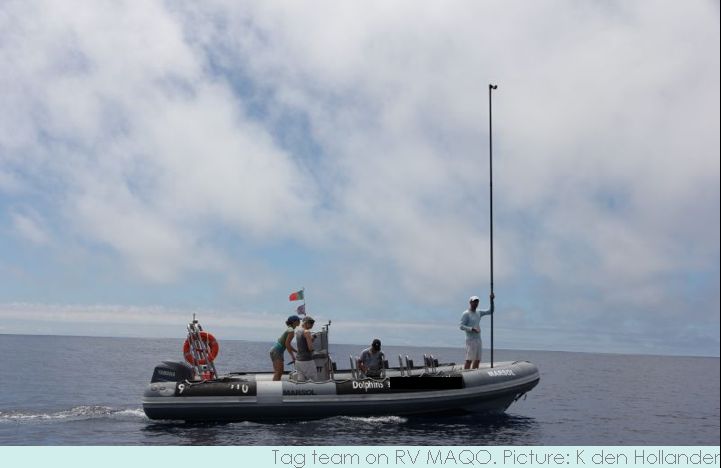First Risso tag on of 2013
RV MAQO, our focal follow and acoustics vessel stayed stationary on the footprint to record the sounds of the group. RV Max, our tagging vessel, travelled slowly in the direction of travel of the beaked whales. Guided by our land team, the tagging team was able to closely approach the whales for tagging. Unfortunately, they stayed just out of reach to deploy a tag.

The tag we use, a DTAG, is attached to the whale with suction cups. It is specifically designed to release from the whale at a pre-set time, or when the individual vividly tries to get it off (for example by breaching).
For the acoustics, this year we are working again with the towed array built by Ricardo Antunes, our tagger and acoustician. The recordings are made on our new acoustic data recorder, which was made available and fully customised for our project by the Behavioural Biology Group of Leiden University in the Netherlands. Thank you!
![]()
The next three days had some very strong team effort, with land and sea teams both working long hours in marginal conditions, rain or wind. Our persistence paid off and resulted in several very good tagging attempts, long focal follows and acoustic recordings of Risso’s dolphins in our research area.
The next day, July 29th we were able to deploy the first DTAG of 2013, on a Risso’s dolphin.
Following a morning with dedicated searching effort from land and sea without any sightings of our target species, Risso’s or beaked whales, we received a call from Ricardo, the vigia (look-out) of one of the local whale-watching companies. He had seen a group Risso’s dolphins 15 km offshore to the east of our research area. We located the group of 20 Risso’s dolphins which were slowly travelling towards open sea. Within 40 minutes after the start of our tagging effort, we deployed a tag on one of the individuals in the group. The tag stayed on the dolphin for more than five hours.

By then we had tracked the tagged individual and its group for 5 hours, during which they were resting and slowly circled the same area. We collected an extensive data set with dive and acoustic data from the tag on the tagged whale, its trajectory and the social and acoustic behaviour of its group, accompanied with photo-ID data to identify all group members.
We are very grateful for the help of Professor Peter Tyack of the Sea Mammal Research Unit at the University of St. Andrews in organising the DTAGs and all associated tracking equipment for our project, making it possible for the Azores-Baseline Project to continue our tagging effort in the Azores, which was initiated in 2012.
Next to observations of our target species, we have many sightings of large groups of common and spotted dolphins, and occasionally of striped dolphins. We have also seen hammerhead sharks, flying fish, a loggerhead turtle, swordfish and –of course- many shearwaters. Following our tag deployment, the weather turned. It has been very windy for the last 4 days, with no opportunity to go out to the land station or to sea. Outside of our effort to process all the data we collected, we have made time for our first tag on celebration and nice evenings by the fire in our forest/back garden. Currently preparing for the next good weather window.